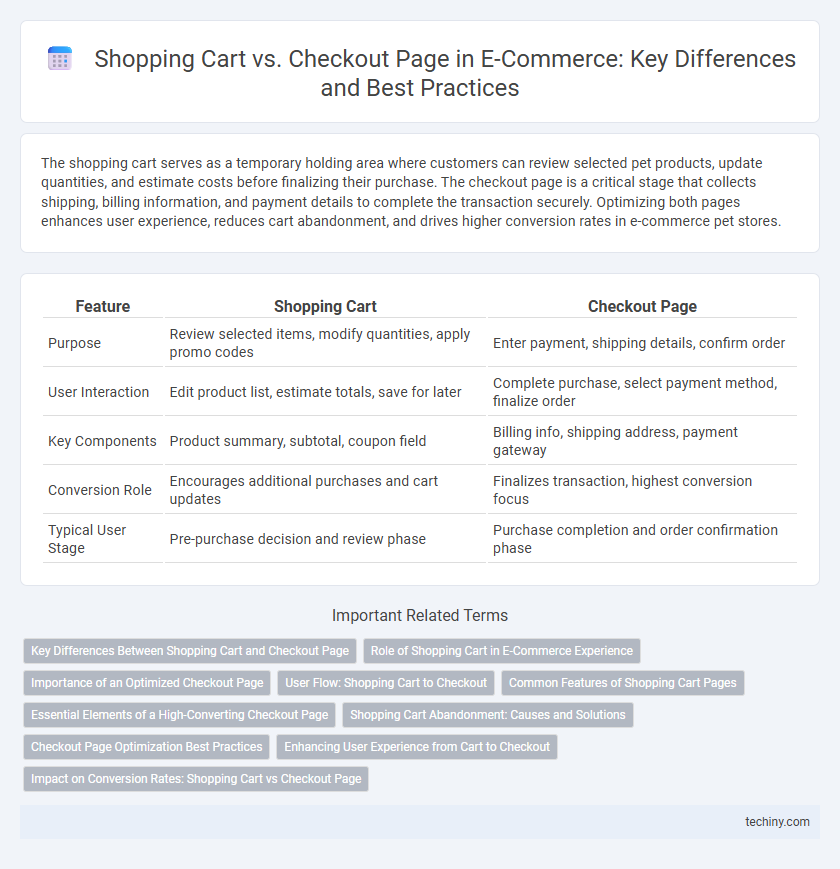The shopping cart serves as a temporary holding area where customers can review selected pet products, update quantities, and estimate costs before finalizing their purchase. The checkout page is a critical stage that collects shipping, billing information, and payment details to complete the transaction securely. Optimizing both pages enhances user experience, reduces cart abandonment, and drives higher conversion rates in e-commerce pet stores.
Table of Comparison
| Feature | Shopping Cart | Checkout Page |
|---|---|---|
| Purpose | Review selected items, modify quantities, apply promo codes | Enter payment, shipping details, confirm order |
| User Interaction | Edit product list, estimate totals, save for later | Complete purchase, select payment method, finalize order |
| Key Components | Product summary, subtotal, coupon field | Billing info, shipping address, payment gateway |
| Conversion Role | Encourages additional purchases and cart updates | Finalizes transaction, highest conversion focus |
| Typical User Stage | Pre-purchase decision and review phase | Purchase completion and order confirmation phase |
Key Differences Between Shopping Cart and Checkout Page
The shopping cart serves as a dynamic container where customers review and modify their selected products, quantities, and pricing before proceeding. The checkout page captures essential customer information, payment details, and shipping options to finalize the purchase transaction securely. Key differences include the shopping cart's role in order management and the checkout page's focus on transaction completion and customer data input.
Role of Shopping Cart in E-Commerce Experience
The shopping cart in e-commerce serves as a dynamic workspace where customers review selected items, update quantities, and estimate total costs before proceeding to payment. It enhances user experience by providing transparency and control over the purchase process, reducing cart abandonment rates. Optimized shopping carts integrate real-time inventory checks, promotional codes, and cross-selling opportunities to boost conversion and average order value.
Importance of an Optimized Checkout Page
An optimized checkout page significantly reduces cart abandonment rates by streamlining the payment process and minimizing distractions. Clear calls-to-action, simplified forms, and multiple payment options enhance user experience and increase conversion rates. Implementing strong security features on the checkout page builds customer trust and encourages completion of purchases in e-commerce platforms.
User Flow: Shopping Cart to Checkout
The user flow from the shopping cart to the checkout page is crucial for maximizing conversion rates in e-commerce. The shopping cart serves as a review area where customers verify selected items, quantities, and pricing, while the checkout page is designed to finalize the purchase by collecting shipping, payment, and billing information. Streamlining this transition with clear calls-to-action and minimal friction points reduces cart abandonment and accelerates the path to purchase.
Common Features of Shopping Cart Pages
Shopping cart pages in e-commerce commonly feature item summaries, including product images, names, quantities, and prices, allowing shoppers to review their selections. They also provide options for updating quantities, removing items, and applying discount codes or coupons directly within the cart interface. Clear subtotal calculations and estimated shipping costs help users understand their potential total before proceeding to the checkout page.
Essential Elements of a High-Converting Checkout Page
A high-converting checkout page in e-commerce must feature a clear summary of cart items, transparent pricing details, and multiple secure payment options to build trust and reduce abandonment rates. Streamlined forms with auto-fill capabilities and visible progress indicators enhance user experience and speed up the purchase process. Prominent call-to-action buttons and real-time error validations ensure customers complete their transactions efficiently, maximizing conversion.
Shopping Cart Abandonment: Causes and Solutions
Shopping cart abandonment occurs when customers add products but leave before completing the purchase, influenced by high shipping costs, complicated checkout processes, and lack of trust signals. Optimizing the shopping cart with transparent pricing, simplified navigation, and clear calls-to-action reduces friction and encourages conversion. Implementing retargeting emails and exit-intent popups recovers potential sales by reminding customers of abandoned items and offering incentives.
Checkout Page Optimization Best Practices
Optimizing the checkout page is crucial for reducing cart abandonment and increasing conversion rates in e-commerce. Key best practices include simplifying form fields to require only essential information, offering multiple secure payment options such as credit cards, digital wallets, and buy-now-pay-later services, and implementing clear progress indicators to guide customers through the process. Enhancing page load speed, providing real-time error validation, and enabling guest checkout further improve user experience and drive successful transactions.
Enhancing User Experience from Cart to Checkout
Streamlining the transition from the shopping cart to the checkout page significantly enhances user experience by reducing cart abandonment rates and simplifying the purchase process. Implementing features such as clear product summaries, dynamic updates of shipping costs, and multiple payment options creates a seamless flow that encourages completion of transactions. Optimizing load speed and minimizing form fields on the checkout page further improve customer satisfaction and increase conversion rates in e-commerce platforms.
Impact on Conversion Rates: Shopping Cart vs Checkout Page
The shopping cart serves as a critical touchpoint where users review selected products, and a well-designed cart minimizes drop-offs by providing clear product summaries and trust signals, enhancing user confidence. The checkout page directly impacts conversion rates by streamlining the payment process, reducing friction with simplified forms and multiple payment options, which decreases cart abandonment. Optimizing both pages with fast load times, transparent pricing, and security assurances significantly increases overall e-commerce conversion rates and boosts revenue.
Shopping Cart vs Checkout Page Infographic

 techiny.com
techiny.com